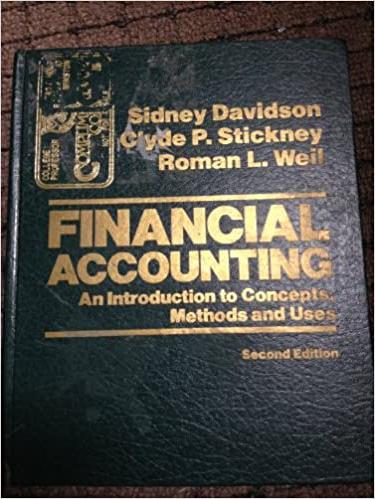help me with questions 1,2,3,4,5 and 6

At the end of Year 5, your consulting firm has been hired by a local service firm to help forecast future uncollectible accounts. For each of the prior five years, you ask the service firm to provide data on the age categories of year-end accounts receivable and the percentage of those accounts that eventually proved uncollectible. With these historical percentages, you estimate a trend line (dashed line) to predict the percentage of uncollectible accounts for Year 6, the upcoming year. Graphs were provided to management from your analysis of each of the three age categories, as well as balances of accounts receivable by age category at the end of Year 5 as follows: Percentage of Uncollectible Accounts: 1-30 Days Past Due Not Yet Past Due Over 30 Days Past Due 40% 0% 10% 38% Year 1 2 3 4 5 6 Year 1 2 3 4 5 6 Year 1 2 3 4 5 6 10% 38% Year 1 2 3 4 5 6 Year 1 2 3 4 5 6 Year 1 2 3 4 5 6 Accounts Receivable by Age: End of Year 5 $140,000 $128.000 $120,000 $100,000 $84,000 $80,000 560,000 540,000 $20,000 $35.000 Not Yet Past Due 1-30 Days Past Due Over 30 Days Past Due Required: 1. Which age categories predicts the lowest percentage of uncollectible accounts for Year 6? 2. Which age categories predicts the highest percentage of uncollectible accounts for Year 6? 3. What is the dollar armount of accounts receivable that are 130 days past due at the end of year 5 (bottom graph)? 4. Calculate the total amount of estimated uncollectible accounts for Year 6 (Hint: Use all three age categories)? 5. Assume the balance of Allowance for Uncollectible Accounts is $4,850 (credit) at the end of Year 5 (before any adjustment). Prepare the adjusting entry at the end of Year 5. 6. Determine the amount of net accounts receivable the company would report at the end of Year 5. Complete this question by entering your answers in the tabs below. Required i Required 2 Required 3 Required 4 Required Required 6 Which age categories predicts the lowest percentage of uncollectible accounts for Year 67 Not yet past due O1-30 days past due Over 30 days past due Required: 1. Which age categories predicts the lowest percentage of uncollectible accounts for Year 6? 2 Which age categories predicts the highest percentage of uncollectible accounts for Year 6? 3. What is the dollar amount of accounts receivable that are 1-30 days past due at the end of year 5 (bottom graphi? 4. Calculate the total amount of estimated uncollectible accounts for Year 6 [Hlint Use all three age categories 5. Assume the balance of Allowance for Uncollectible Accounts is $4.850 (credit) at the end of Year 5 (before any adjustment). Prepare the adjusting entry at the end of Year 5. 6. Determine the amount of net accounts receivable the company would report at the end of Year 5 Complete this question by entering your answers in the tabs below. Required 1 Required 2 Required 3 Required 4 Required Required 6 which age categories predicts the highest percentage of uncollectible accounts for Year 67 Not yet past due O1-30 days past due Over 30 days past due 1. Which age categories predicts the lowest percentage of uncollectible accounts for Year 6? 2. Which age categories predicts the highest percentage of uncollectible accounts for Year 6? 3. What is the dollar amount of accounts receivable that are 1-30 days past due at the end of year 5 (bottom graphi? 4. Calculate the total amount of estimated uncollectible accounts for Year 6 (Hint: Use all three age categories)? 5. Assume the balance of Allowance for Uncollectible Accounts is $4,850 (credit) at the end of Year 5 (before any adjustment). Prepare the adjusting entry at the end of Year 5. 6. Determine the amount of net accounts receivable the company would report at the end of Year 5. Complete this question by entering your answers in the tabs below. Required 1 Required 2 Required 3 Required 4 Required 5 Required 6 Assure the balance of Allowance for Uncollectible Accounts is $4,850 (credit) at the end of Year 5 (before any adjustment). Prepare the adjusting entry at the end of Year 5. (If no entry is required for a particular transaction/event, select "No Journal Entry Required in the first account field.) View transaction list Journal entry worksheet View transaction list Journal entry worksheet Record the adjustment to the allowance for uncollectible accounts. Note: Enter debits before credits. Event General Journal Debit Credit Record entry Clear entry View general journal Lynn Ly ULUL AL . 2. Which age categories predicts the highest percentage of uncollectible accounts for Year 67 3. What is the dollar amount of accounts receivable that are 130 days past due at the end of year 5 (bottom graphi? 4. Calculate the total amount of estimated uncollectible accounts for Year 6 [Hint Use all three age categories)? 5. Assume the balance of Allowance for Uncollectible Accounts is $4,850 (credit) at the end of Year 5 (before any adjustment). Prepare the adjusting entry at the end of Year 5 6. Determine the amount of net accounts receivable the company would report at the end of Year 5 Complete this question by entering your answers in the tabs below. Required 1 Required 2 Required 3 Required 4 Required 5 Required 6 Determine the amount of net accounts receivable the company would report at the end of Year 5 Net Accounts Receivable (Required 5 Required )
















